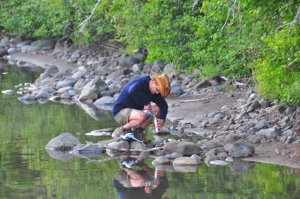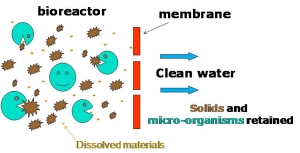Environmental contamination continues to be a hot-button issue in the United States. From the closing statements in the Democratic Presidential Debate in Charleston, South Carolina to the trending Michigan State of the State Address, water contamination in Flint, Michigan is making the news daily. So are updates on the Porter Ranch gas leak and its widespread effects on the environment and economy.

Uncapped spent fuel stored underwater at Hanford site.
And cleaning up contamination can be very expensive. For example, the Hanford Nuclear Reservation in Washington is the largest nuclear waste cleanup in America, with a price tag of $40 billion to date and much work left to do. Another familiar example is the 2010 Deepwater Horizon oil spill; after a recent settlement in October 2015, BP estimated its total costs for the disaster at $54.6 billion. It is easy to see why pollution from human actions has become one of the country’s greatest environmental concerns.
Given the daily threat of environmental contamination and the disastrous effects it can have on human health, the environment, and the economy, organizations around the world are constantly looking for ways to prevent, detect, and/or clean up after these incidents. The current pace of technological change means that new ideas are being introduced that can have lasting effects on the environmental landscape.
Preventing Contamination
- The Electric Power Board (EPB) of Chattanooga is a city-owned electricity distribution and telecommunications company. In addition to being the first company in the United States to provide 1-gigabit (1,000 megabits per second) high-speed Internet and the world’s first community to provide community-wide 10-gigabit Internet service, EPB Chattanooga also has the most automated Smart Grid system in the nation. This system is intelligent and self-healing, allowing power to be rerouted around problem areas to prevent outages that can cause disastrous contamination events like the raw sewage spill into Los Penasquitos Lagoon in California.
- Marine Environmental Remediation Group (MER) uses green technology to reclaim steel and other metals from platforms and sea vessels that have been retired from use in a way that meets or exceeds all applicable regulations. This proprietary invention maintains the ship’s watertight integrity while large sections are removed, preventing contaminants from touching the surrounding water.
Detecting Contamination

Water sampling, courtesy of Wikimedia Commons user Ashjaymohsin, CC BY-SA 3.0.
- The King County Environmental Lab in Washington is using a type of DNA testing to identify bacteria in local bodies of water. The technique is able to determine if human waste is causing contamination in the water. Along with a measuring tool called a thermistor that can “identify spikes of contamination through factors of heat and conductivity,” it is possible to track sources of pollution.
- Wearable devices are all the rage with consumers wanting to track their unique experiences. While fitness trackers are currently the most popular devices, companies are developing wearables that can monitor air quality for anything from pollutants to ultraviolet (UV) rays. This data can also be used to crowdsource real-time pollution maps to detect what areas have undesirable levels of contamination. Companies such as Lapka PEM, TZOA, and AirBeam track environmental data from each device, which can then be uploaded to an online platform to be shared with all users.
- FREDSense is a young company, started by graduate and undergraduate students at the University of Calgary. The company has developed a portable sensor that can detect many different substances in the water supply, including heavy metals and pesticides.
Cleaning Up Contamination

Simple schematic of a membrane bioreactor system, courtesy of M brannock at English Wikipedia, CC BY-SA 3.0.
- Numerous technologies are being developed to remove contaminants from wastewater. Honeywell UOP is currently using its XCeed bioreactor technology to help a Wyoming refinery meet new environmental requirements. XCeed helps remove both organic and inorganic contaminants from wastewater. Meanwhile, a U.S. patent was recently awarded to a Canadian company and a research university for their membrane bioreactor system that removes some of the top emerging micropollutants, such as bisphenol-A (BPA), from industrial wastewater.
- Maria Elena Grimmett, a senior high school student in Florida, recently won a $100,000 college scholarship and the top individual prize at the 2015 Siemens Competition in Math, Science and Technology for her discovery of a way to remove sulfamethazine, a common veterinary antibiotic that contaminates soil and water.
- Meanwhile, the Italian Dynamic Legged Systems (DLS) lab is developing a quadruped robot with a robotic arm that would have improved maneuverability and dexterity compared to previous robots. The HyQ robot could replace a human in a dangerous situation such as collecting a sample in a severely contaminated area.
From the Bucket Brigade in the early 1990s to now, emerging technology has always played a part in the environmental landscape. What new technology will be developed in the next 10 years or even 5 years? Regardless of what innovations will be developed, new technology will forever change the environmental landscape.





Recent Comments